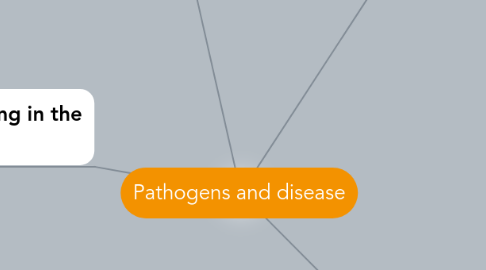
1. Preventing pathogens getting in the body
1.1. skin covers body and acts as a barrier preventing pathogens reaching tissues below
1.1.1. Prepare Product Evaluation
1.1.2. Conduct Product Evaluation
1.1.3. Initiate Maintenance Process
1.2. if you cut yourself the blood will clot forminga scab stopping pathogens entering
1.2.1. Prepare for Project Closure Meeting
1.2.2. Conduct Project Closure Meeting
1.2.3. Follow Up Project Closure Meeting
1.3. breathing in/out through nose could be a weakness of the body BUT mucus produced by your breathing system covers lining of lungds/tubes and traps pathogens. Mucus either then removed directly or swallowed where acid in stomach kills pathogens
1.3.1. Prepare Project Review
1.3.2. Conduct Project Review
1.3.3. Implement Process Improvement
1.4. pathogens taken in via mouth end up in stomach and acid there destroys them
2. How do pathogens get in your body?
2.1. Droplet infection eg cough, sneeze, talk you expel little droplets full of pathogen and other breathe them in eg flu
2.1.1. Establish checkpoints
2.1.2. Acquire team resources for stage
2.1.3. Conduct stage kick-off meeting
2.2. direct contact of the skin eg imetigo, sexual diseases eg genitel herpes
2.2.1. Determine Frequency of Meetings
2.2.2. Schedule Meetings
2.2.3. Brief Project Board
2.2.4. Prepare Meetings
2.2.5. Conduct Meetings
2.2.6. Follow-up Meeting
2.3. eating contaminated food/drink eg raw food -= pathogens go straigh into gut and cause diarrhoea/salmonellosis
2.3.1. Schedule Quality Review Meeting
2.3.2. Prepare for Quality Review Meeting
2.3.3. Conduct Quality Review Meeting
2.3.4. Follow-up Quality Review Meeting
2.4. through a break in your skin -cuts/scratches etc eg HIV/aids, hepatitis
2.4.1. Update Project Schedule
2.4.2. Update Budget / Costs
2.4.3. Conduct Team Status Review
2.4.4. Create Status Report
3. What happens if pathogens do get in - white blood cells of the immune system are the second line of defence
3.1. Some WBC ingest microorganisms destroying them
3.2. some WBC produce special chemicals called antibodies which target certain bacteria or viruses.
3.2.1. each pathogen requires a unique antobody
3.2.2. once WBC produced an antibody once they can easily do again next time required
3.3. some WBC produce antitoxins which counteracttoxins produced by bacteria
3.4. learn diagram p 33
4. Pathogens
4.1. are microorganisms that cause disease
4.1.1. Recruit Project Sponsor
4.1.2. Recruit Project Manager
4.1.3. Review Related Projects and Lessons Learned
4.1.4. Prepare Project Initiation Plan
4.1.5. Brief the Initial Project Team
4.1.6. Review Project Kick-off Plans and Presentation Map
4.1.7. Hold Project Kick-off Meeting
4.2. common ones are bacteria and viruses
4.2.1. bacteria are single celled organisms that are smaller than animal/plant cells
4.2.2. some bacteria are useful eg make mediciine, treat sewage,make food eg yoghurt
4.2.3. viruses are even smaller and cause disease in every living organism incl bacteria
4.3. an infectious disease is caused by a pathogen entering and attacking your body
4.3.1. they multiply rapidly
4.3.2. bacteria split in 2 and produce toxins. sometimes directly damage the cells
4.3.3. viruses take over the cells, damaging and destroying them as they reproduce. they rarely produce toxins
4.4. infectious means can be passed from person to person
4.4.1. you catch an infectious disease by picking up a pathogen from someone who has the disease
4.5. some infectious diseases eg colds are mild but some can kill eg HIV/aids
4.5.1. signs are high temperatures, rashes, headaches caused by the damage to the cells
4.6. Ignaz Semmelweis
4.6.1. doctor in mid 1850s
4.6.2. recognised importance of handwashing in preventing spread of infectious disease in hospitals
4.6.3. understood that something invisible/infectious agent was being passed on
4.6.4. doctors going from case to case were passing disease on
4.6.5. still critical today esp as some pathogens become resistant to antibiotics
4.7. Ways to stop spreading pathogens
4.7.1. wash hands eg before prepare food, after toilet
4.7.2. cover nose and mouth when sneeze
4.7.3. keep away from others if ill
4.7.4. medicines eg antibiotics kill bacteria
4.7.5. general cleanliness
4.7.6. rubber gloves worn by staff in kichens
